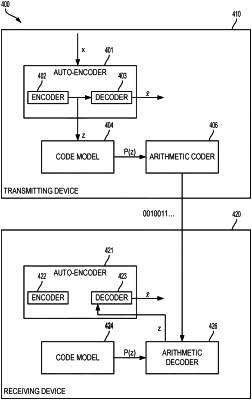| CPC H04N 19/149 (2014.11) [G06N 3/045 (2023.01); G06N 3/084 (2013.01); G06N 20/20 (2019.01); H04N 19/117 (2014.11); H04N 19/172 (2014.11); H04N 19/31 (2014.11)] | 30 Claims |

|
11. A system for compressing video, comprising:
at least one processor configured to:
receive video content for compression;
encode, into a code in a latent code space, the video content through an auto-encoder implemented by a first artificial neural network configured to execute on the at least one processor, wherein the code in the latent code space represent a lossy encoding of the received video content such that decoding the code results in an approximation of the received video content;
generate a losslessly compressed version of the code in the latent code space through a probabilistic model implemented by a second artificial neural network configured to execute on the at least one processor; and
output the losslessly compressed version of the code in the latent code space for transmission; and
a memory coupled to the at least one processor.
|